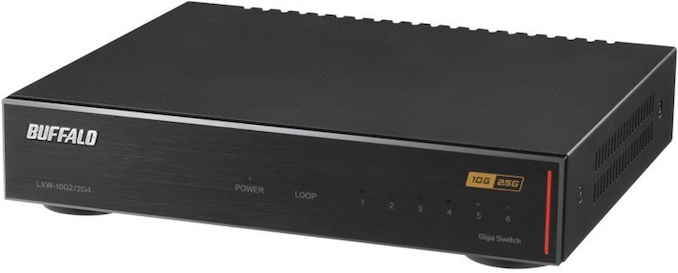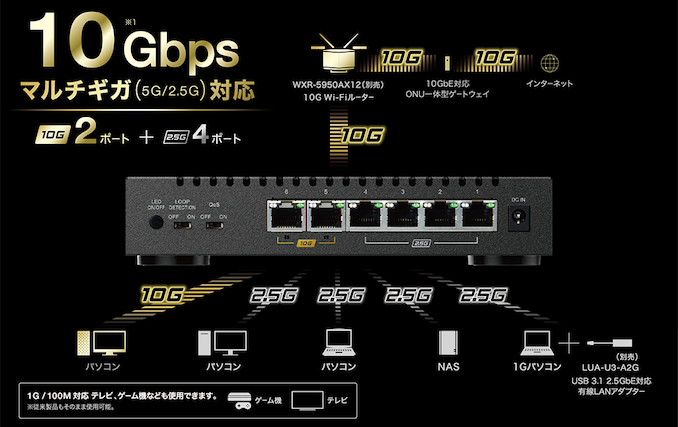Buffalo Releases LXW-10G2/2G4 Switch: Two 10 GbE + Four 2.5 GbE Ports
by Anton Shilov on November 13, 2019 5:00 PM EST- Posted in
- Networking
- 10G Ethernet
- Buffalo
- Switch
- Ethernet
- 2.5 GbE

One of the big reasons for why faster-than-GbE networks have not gained traction in the consumer space is due to a lack of appropriate network switches. 10 GbE switches are generally aimed at businesses, and they are priced accordingly. Fortunately, the situation is beginning to change. Buffalo Japan has introduced its new six-port switch featuring two 10 GbE ports and four 2.5 GbE ports that is designed for home use.
Buffalo’s LXW-10G2/2G4 Giga Switch is aimed at homes with a high-speed optical Internet connectivity as well as multiple computers or NAS with 2.5 GbE or 10 GbE network adapters and/or Gigabit-class Wi-Fi. The switch can automatically prioritize 10 GbE connectivity and also supports loop detection to optimize a network’s configuration and performance. Besides the switch, Buffalo also offers its WXR-5950AX12 10G Wi-Fi router as well as LUA-U3-A2G 2.5 GbE USB adapter for PCs.
Buffalo’s LXW-10G2/2G4 switch will be available starting from mid-December exclusively in Japan, but nothing stops the company to start sales of the product elsewhere. The price of the switch will be approximately ¥34,000 including taxes ($312 with VAT, $283 w/o VAT), which is quite expensive even by Japanese standards. Though at least for the time being, it's a rather unique offering in the consumer switch space; similar switches with a mix of ports have generally combined 10 GbE with pure GbE, so the use of 2.5 GbE ports makes for an interesting development.
Related Reading:
- Realtek 2.5 GbE PCIe Cards Now For Sale
- Intel Quietly Mentions 2.5 GbE Ethernet Controllers
- Netgear Expands Insight-Supported Network Switch Lineup
- GIGABYTE’s GC-AQC107 10G Ethernet PCIe Card Launched and Listed
- Aquantia Multi-Gig: Single Chip USB 3.0 to 5G/2.5G Dongles Coming Soon
- ASUS Launches XG-C100C 10 GBase-T Adapter: Aquantia AQC107, $99
Source: Buffalo Japan (via PC Watch, Hermitage Akihabara)











45 Comments
View All Comments
Duncan Macdonald - Wednesday, November 13, 2019 - link
With only 2 10G ports, it is not suitable for a simple 10G network. At least 4 ports need to be 10G to allow a simple network with all devices having 10G. Also the price is hopeless for domestic use (an 8 port 1G switch can be purchased new for under £10)For 10G to become common in domestic use requires an 8 port switch with at least 4 10G ports for under £50 and 10G ports becoming common on PC motherboards.
khanikun - Wednesday, November 13, 2019 - link
Ya, the price is still pretty hopeless. It'd say it'd be a different story if this were a wifi router with 10g ports and a bunch of gaming centric options built in. Then it'd be like a lot of those "gaming" routers on the market for $300.For most users two 10G ports is enough. For a power user, I'd want all the ports to be 10g. I went with a Microtek four 10g SFP port switch, three Intel X520-DA1, and some direct attach SFP+ cables. I would have preferred to not be on SFPs, but it was the cheapest solution at $310 all in.
GreenReaper - Wednesday, November 13, 2019 - link
If you have one 10G port going to a home server, the other to your main computer or a Wi-Fi router, and the 2.5G links going to the Internet and other devices, etc. I think it makes some sense.Not everything needs 10G. For many things being able to access content at 250MB/sec is plenty. Especially considering most *new* devices are still 1G - although that may well change soon.
Kjella - Thursday, November 14, 2019 - link
Approximately 0.0001% of the population have any use for a 2.5G port to the Internet. Apart from externalizing your storage at a ridiculous cost I don't see the use case, you can buy very big/fast local SSDs for the same money.name99 - Thursday, November 14, 2019 - link
Which part of "One of the big reasons for why faster-than-GbE networks have not gained traction in the consumer space is due to a lack of appropriate network switches." did you not understand?There is a chicken and egg situation here.
There are at least SOME machines with native 10GbE, for example iMac Pro and the newest Mac Mini. Also anything with TB3/USB could buy an ethernet adaptor and, more significantly, anything with USB3 could buy a 2.5GbE adaptor.
Buying those adaptors has so far not made sense because of the lack of a home-appropriate switch. This device helps solve that. (Perhaps... One part of being home appropriate is small enough; a second part is not requiring a fan. This box looks like it may well have a fan, at which point noise issue become important...)
Yes, in a perfect world we'd all get free 10G ethernet switches and a unicorn in our breakfast cereal boxes. In the real world
- 2.5G is still faster than 1G, and is what's most practical for many people given what I said about 2.5G adaptors hooked to USB3.
- two 10G ports gives you a LOT more flexibility than the single 10G port you get in most of the marginally equivalent CONSUMER equipment (like a lot of the newest expensive 802.11ax routers)
If it costs too much for you, don't buy it. But how do you think computer economics works? This stuff starts off expensive, next year it will be half the price, three years later half again.
The IMPORTANT step is that first step, the step that transitions from the enterprise to the consumer market.
close - Sunday, November 17, 2019 - link
@name99 : "Which part of "One of the big reasons for why faster-than-GbE networks have not gained traction in the consumer space is due to a lack of appropriate network switches." did you not understand?"The BS/PR part? It's like saying "the reason jet engines didn't catch on in road cars is the price of JP-8 fuel". Most regular users moved from the faster wired GbE to the slower, less stable WiFi because of convenience. They don't care about 2.5G or even 10G because they don't care about cables. And very few copy stuff around the network often enough to care. You live in a bubble reading these news and assuming most people care but they don't. Which is why those prices are high - demand is low.
The funniest part is that you take one of Anton Shilov's articles as anything more that transcripts of press releases from manufacturers, complete with errors and misleading PR. Makes me suffer a lot less about for reading the rest of your no doubt valuable explanation.
khanikun - Monday, November 18, 2019 - link
I agree with this. Not much demand for wired networks in general. Majority of regular consumers want wireless everything.For the niche market of power users, like many of us, it's a lack of network switches or product price. I don't see the situation changing anytime soon. Few of us just roll with the inconveniences and just get our 10G on, while most aren't touching it and complaining.
azazel1024 - Friday, November 15, 2019 - link
Sure some sense, but not at that price. Maybe if the street price is significantly lower.Netgear has their 10 port multigig router. $269 street price that is sometimes $20-40 less.
1 10GbE port, 1 10Gb SFP+ port, 2 2.5GbE ports and 2 5GbE ports. 5 regular GbE ports.
Not quite equivalent sure, but a little cheaper.
Still hoping and waiting for something that is more like $20-30 a port price and multigig capable. The Buffalo is just about perfect for what I'd want. I'd assume those 10GbE ports are capable of 5/2.5 speeds also. Or I should say I hope.
Running 5/10GbE between my desktop and server is perfect. That reserves a couple of 2.5GbE ports for future router/WAP use and run 1 or 2 2.5GbE port to my core switch (assuming it can do LAG, but even just 1 port). I don't need every port on my network to be 2.5GbE or faster, but I'd like a minimum of 4 ports at that speed. If I can get 2 ports at 5GbE that'd be nice too. LAG would be important, or at least nice so that I could link it to my core switch and get 2Gbps between it and the remainder of my network.
khanikun - Monday, November 18, 2019 - link
For me, I just wanted my 3 desktops to have 10G to each other. Really, only two of them needed it, but for an extra like $50, might as well make that 3rd one 10G. I download things on my main computer, then move them to my file server. I'll transfer like 2-3 TBs at a time, sometimes more. Only happens like once a month, but it'd be nice to have it finish quickly, as opposed to starting it before going to sleep.Everything will just be connected to the internet at 1G speeds. I only have a 300 mbps connection, so I couldn't make use of 10G to the outside world, let alone 1G.
inighthawki - Wednesday, November 13, 2019 - link
Generally the goal of switches like this is to provide a high bandwidth pipe to a highly constrained resource and then smaller pipes to multiple devices consuming it. You can connect the 10G line to a media/file server and have 4 connected PCs all consume content at 2.5G without bottlenecking the server.